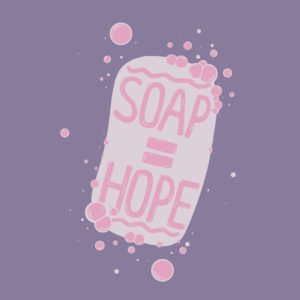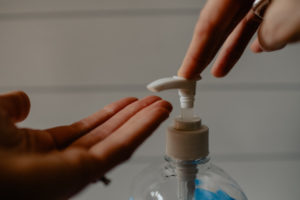 If you’re interested in preserving your health then you’ve probably realised that chemical-free cleaning products are integral.
If you’re interested in preserving your health then you’ve probably realised that chemical-free cleaning products are integral.
The EWG (Environment Working Group) has investigated more than 2,000 cleaning supplies on the American market and found startling information about the substances used in many everyday products. This is still relevant for those living outside of the US as many cleaning brands are sold internationally or use generic harmful ingredients.
Here are some highlights1:
- Fumes from cleaning products may induce asthma or other respiratory problems.
- Many of these products include potentially carcinogenic ingredients like 1,4-dioxane.
- Children born to women who have cleaning jobs have an elevated risk of birth defects.
- Some cleaners can cause chemical burns, poisonings, and allergies.
While government regulatory agencies do focus their attention on potential cancer-causing ingredients, other harmful compounds slip by and may be lurking in the products you use on a regular basis. For instance, far fewer resources are devoted to looking into chemicals that can cause brain and nervous system toxicity, hormone imbalance, or organ dysfunction1.
The good news is, information is power. If you want to protect yourself and your family from the hidden toxins in your cleaning products, all you need to do is be aware.
 8 Hidden Toxins In Your Cleaning Products
8 Hidden Toxins In Your Cleaning Products
#1 Phthalates
Phthalates are often used in products that have a fragrance (which is almost every product out there). In fact, if you see the word “fragrance,” there’s a good chance that phthalates are hidden in there too.
Health Issues2:
Phthalates are endocrine-disrupting chemicals that can interfere with normal growth and development. Research shows this can be especially devastating for males during the reproductive stage. Phthalates are also considered to be reproductive toxins affecting both male fertility and the quality of their sperm.
Animal studies also show that phthalates may be carcinogenic, with an affinity to breast tissue and liver.
Products Containing Phthalates2:
- Air fresheners
- Dish soap
- Tissues
- Laundry detergent
- Pretty much anything with a fragrance
 #2 Triclosan
#2 Triclosan
Triclosan is used as an antimicrobial agent in soaps and detergents. The primary issue with triclosan is its role in creating antibiotic resistance. Research shows that as the use of this compound increases, more strains of antimicrobial drug-resistance bacteria are popping up. Antibiotic-resistance is a massive issue as it creates strains of bacteria that can outsmart the drugs meant to control their proliferation.
Health Issues3:
Along with antibiotic resistance, triclosan is also a known endocrine-disrupting compound — specifically targeting the thyroid gland. In addition, triclosan can interfere with the expression of both androgen and estrogen-sensitive genes.
Furthermore, due to its affinity for fat tissue, triclosan can easily accumulate in your body. In fact, the CDC stated that 75% of the people they tested had levels of triclosan in their urine.
Products Containing Triclosan3:
- Antibacterial soaps
- Detergents
- Anything labeled “antibacterial”
 #3 Ammonia
#3 Ammonia
Ammonia is often used to break down fats and grime on household surfaces like tubs, sinks, and toilets. Right off the bat, you’ll see that cleaning products containing ammonia often recommend that you only use it in well-ventilated areas — this should be your first red flag. Ammonia is linked to respiratory issues when inhaled and can become downright poisonous if mixed with bleach.
Health Issues4:
The primary health issue associated with ammonia is respiratory health. Inhaled ammonia can result in breathing issues in the elderly, those with asthma, and in people who get a lot of ammonia exposure, it can lead to the development of chronic bronchitis or other respiratory issues.
Products Containing Ammonia4:
- Window cleaners
- Polishing agents for fixtures
- Glass cleaners
#4 Chlorine
Chlorine is the primary ingredient in bleach and is used in many cleaning products for its corrosive properties. Chlorine is also found in city water as a way to manage bacterial growth and to kill disease-causing pathogens.
Health Issues:
Chlorine can become a serious thyroid hormone inhibitor due to its affinity for the iodine molecule. Iodine is a crucial nutrient for thyroid hormone production, but when chlorine and iodine bind together, it leaves less available iodine for your thyroid to work with5.
Chlorine may also instigate respiratory issues on an acute level when inhaled, and can cause eye, skin, and airway irritation. If chlorine is ingested, its corrosive nature can also cause damage to your GI tract6.
Products Containing Chlorine6:
- Toilet bowl cleaners
- Mildew removes
- Laundry detergent
- Bleach
- Tap water
 #5 Quaternary Ammonium Compounds
#5 Quaternary Ammonium Compounds
Quaternary Ammonium Compounds, also called QUATS, are commonly used as disinfectants and carry the same burden as triclosan when it comes to antibiotic resistance.
Health Issues:
Due to their strong disinfectant abilities, QUATS can cause severe skin burns and irritation. In fact, there is some research that suggests that these compounds may be a contributing cause of contact dermatitis7.
When inhaled, QUATS presents a potential threat to those with respiratory issues and may instigate the onset of asthma8.
Products Containing QUATS7:
- Oven cleaner
- Drain clog remover
- Toilet cleaner
- Stove Top cleaner
- Cleaning wipes
#6 -1,4-Dioxane
1,4-Dioxane is found in products that make suds like soaps and detergents. This compound won’t be found on an ingredient list because it’s actually a contaminant that’s created when other chemicals are mixed together.
Health Issues9:
The primary health concern related to 1,4-dioxane is its carcinogenic potential. Due to the fact that this compound readily penetrates into your skin, the use of any products containing 1,4-dioxane should be carefully considered.
The EPA (environmental protection agency) considers 1,4-dioxane a probable carcinogen and is listed as an animal carcinogen by the National Toxicology Program.
 Products Containing 1,4-dioxane9:
Products Containing 1,4-dioxane9:
- Bleach
- Liquid soap
- Dish soap
- Detergent
- Anything that creates suds
#7 Ethanolamine Compounds
Ethanolamine compounds are a group of chemicals used in a wide range of products as emulsifiers, and when combined with certain preservatives, they create potentially carcinogenic nitrosamines. These products are best known for their ability to remove dirt– which makes them a favorite for household cleaning product formulators.
Health Issues10:
The primary concern with ethanolamine compounds is their carcinogenic potential when mixed with preservatives. Animal research shows that the nitrosamines created in this reaction may lead to liver cancer as well as kidney tumors (more clinical studies are necessary).
One type of ethanolamine, DEA, has been linked to male reproductive harm and potential infertility. These compounds may also lead to organ toxicity as they tend to accumulate in the liver and kidney.
Products Containing Ethanolamine Compounds10:
- Soaps
- Floor cleaners
- Tile cleaners
- Laundry detergent
 #8 Benzyl Acetate
#8 Benzyl Acetate
Benzyl acetate is used primarily as a fragrance for its sweet and delicate aroma. Don’t be fooled by the pleasant smell, however, this chemical is incredibly toxic.
Health Issues:
When inhaled, benzyl acetate may cause respiratory issues like laboured breathing and sore throat. In some cases, it may even lead to dizziness, confusion, and fatigue as this compound has an effect on your central nervous system.
Although rare, if benzyl acetate is ingested your body will respond with diarrhea and vomiting, and for some people, this could result in convulsions12.
Products Containing Benzyl Acetate11:
- Dryer sheets/fabric softeners
- Dishwashing detergent
- Fabric cleaners
- Air fresheners
We hope this helps builds your certainty about why to avoid cleaning products that contain these ingredients.
Related Posts:
Chemicals To Avoid In Self Care And Home Care Products
Non-Toxic Yummy Toothpaste Anyone?
Triclosan: Is It Banned or Not Banned?
Cleaning Products And Cancer: Is There A Link?
References:
- https://www.ewg.org/guides/cleaners/content/cleaners_and_health/
- https://www.safecosmetics.org/get-the-facts/chemicals-of-concern/phthalates/
- https://www.safecosmetics.org/get-the-facts/chemicals-of-concern/triclosan/
- https://www.chemicalsafetyfacts.org/ammonia/
- Harrington, R. M., H. G. Shertzer, and J. P. Bercz. “Effects of chlorine dioxide on thyroid function in the African green monkey and the rat.” Journal of Toxicology and Environmental Health, Part A Current Issues19.2 (1986): 235-242.
- https://www.health.ny.gov/environmental/emergency/chemical_terrorism/chlorine_tech.htm
- Shmunes, Edward, and Edwin J. Levy. “Quaternary ammonium compound contact dermatitis from a deodorant.” Archives of Dermatology105.1 (1972): 91-93.
- Gonzalez, Maria, et al. “Asthma and exposure to quaternary ammonium compounds in healthcare settings.” (2011).
- https://www.safecosmetics.org/get-the-facts/chemicals-of-concern/14-dioxane/
- https://www.safecosmetics.org/get-the-facts/chemicals-of-concern/ethanolamine-compounds/
- https://pubchem.ncbi.nlm.nih.gov/compound/Benzyl-acetate#section=Industry-Uses
- https://www.ilo.org/dyn/icsc/showcard.display?p_lang=en&p_card_id=1331&p_version=2








